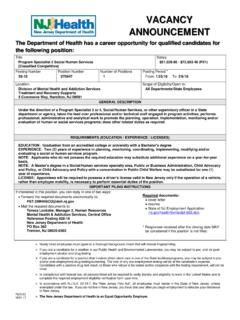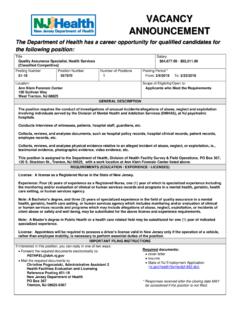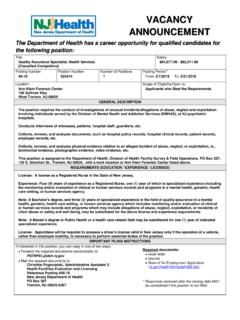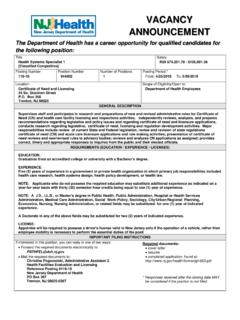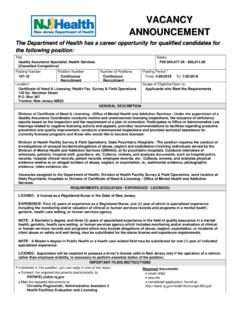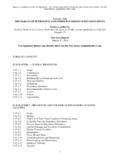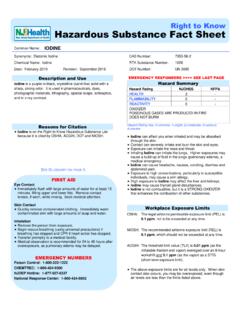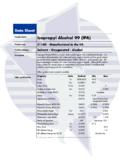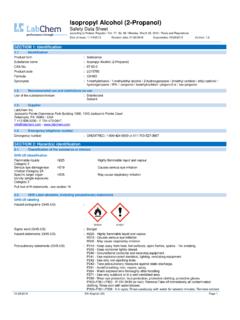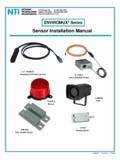Transcription of Right to Know Hazardous Substance Fact Sheet - New Jersey
1 Right to Know Hazardous Substance Fact Sheet Common Name: dipropylene glycol methyl ETHER. Synonyms: Dowanol DPM; DPGME CAS Number: 34590-94-8. Chemical Name: Propanol, 1(or 2)-(2-Methoxymethylethoxy)- RTK Substance Number: 0804. Date: December 1998 Revision: February 2008 DOT Number: None Description and Use EMERGENCY RESPONDERS >>>> SEE BACK PAGE. dipropylene glycol methyl Ether is a colorless liquid with a Hazard Summary mild and pleasant odor. It is a solvent used in paints, pastes, Hazard Rating NJDOH NFPA. dyes, resins, brake fluids and inks, and in making cosmetics.
2 HEALTH - 2. FLAMMABILITY - 2. f ODOR THRESHOLD = 35 ppm REACTIVITY - 0. f Odor thresholds vary greatly. Do not rely on odor alone to determine potentially Hazardous exposures. COMBUSTIBLE. POISONOUS GASES ARE PRODUCED IN FIRE. Hazard Rating Key: 0=minimal; 1=slight; 2=moderate; 3=serious;. 4=severe Reasons for Citation f dipropylene glycol methyl Ether is on the Right to Know f dipropylene glycol methyl Ether can affect you when Hazardous Substance List because it is cited by OSHA, inhaled and may be absorbed through the skin.
3 ACGIH, NIOSH and NFPA. f Contact can irritate the skin. f Exposure can irritate the eyes, nose and throat. f dipropylene glycol methyl Ether can cause headache, dizziness, lightheadedness, and passing out. f Repeated exposure to very high levels may affect the liver. Workplace Exposure Limits SEE GLOSSARY ON PAGE 5. OSHA: The legal airborne permissible exposure limit (PEL) is 100 ppm averaged over an 8-hour workshift. FIRST AID. Eye Contact f Immediately flush with large amounts of water for at least 15 NIOSH: The recommended airborne exposure limit (REL) is minutes, lifting upper and lower lids.
4 Remove contact 100 ppm averaged over a 10-hour workshift and lenses, if worn, while rinsing. 150 ppm, not to be exceeded during any 15-minute work period. Skin Contact f Remove contaminated clothing and wash contaminated skin with soap and water. ACGIH: The threshold limit value (TLV) is 100 ppm averaged over an 8-hour workshift and 150 ppm as a STEL. Inhalation (short-term exposure limit). f Remove the person from exposure. f Begin rescue breathing (using universal precautions) if breathing has stopped and CPR if heart action has stopped.
5 F The above exposure limits are for air levels only. When skin f Transfer promptly to a medical facility. contact also occurs, you may be overexposed, even though air levels are less than the limits listed above. EMERGENCY NUMBERS. Poison Control: 1-800-222-1222. CHEMTREC: 1-800-424-9300. NJDEP Hotline: 1-877-927-6337. National Response Center: 1-800-424-8802. dipropylene glycol methyl ETHER Page 2 of 6. Determining Your Exposure Reproductive Hazard f According to the information presently available to the New f Read the product manufacturer's Material Safety Data Jersey Department of Health, dipropylene glycol methyl Sheet (MSDS) and the label to determine product Ether has been tested and has not been shown to affect ingredients and important safety and health information reproduction.
6 About the product mixture. Other Effects f For each individual Hazardous ingredient, read the New f Repeated exposure to very high levels may affect the liver. Jersey Department of Health Hazardous Substance Fact Sheet , available on the RTK website ( ) or in your facility's RTK. Central File or Hazard Communication Standard file. Medical f You have a Right to this information under the New Jersey Medical Testing Worker and Community Right to Know Act, the Public If symptoms develop or overexposure is suspected, the following are recommended: Employees Occupational Safety and Health (PEOSH) Act if you are a public worker in New Jersey , and under the f Liver function tests federal Occupational Safety and Health Act (OSHA) if you are a private worker.
7 Any evaluation should include a careful history of past and f The New Jersey Right to Know Act requires most present symptoms with an exam. Medical tests that look for damage already done are not a substitute for controlling employers to label chemicals in the workplace and exposure. requires public employers to provide their employees with information concerning chemical hazards and controls. Request copies of your medical testing. You have a legal Right The federal OSHA Hazard Communication Standard (29 to this information under the OSHA Access to Employee CFR ) and the PEOSH Hazard Communication Exposure and Medical Records Standard (29 CFR ).
8 Standard ( 12:100-7) require employers to provide similar information and training to their employees. Mixed Exposures f More than light alcohol consumption can cause liver This Fact Sheet is a summary of available information damage, drinking alcohol may increase the liver damage regarding the health hazards that may result from exposure. caused by dipropylene glycol methyl Ether. Duration of exposure, concentration of the Substance and other factors will affect your susceptibility to any of the potential effects described below.
9 Health Hazard Information Acute Health Effects The following acute (short-term) health effects may occur immediately or shortly after exposure to dipropylene glycol methyl Ether: f Contact can irritate the skin. f Exposure can irritate the eyes, nose and throat. f dipropylene glycol methyl Ether can cause headache, dizziness, lightheadedness, and passing out. Chronic Health Effects The following chronic (long-term) health effects can occur at some time after exposure to dipropylene glycol methyl Ether and can last for months or years: Cancer Hazard f According to the information presently available to the New Jersey Department of Health, dipropylene glycol methyl Ether has not been tested for its ability to cause cancer in animals.
10 dipropylene glycol methyl ETHER Page 3 of 6. Workplace Controls and Practices Eye Protection Very toxic chemicals, or those that are reproductive hazards or f Wear indirect-vent, impact and splash resistant goggles sensitizers, require expert advice on control measures if a less when working with liquids. toxic chemical cannot be substituted. Control measures f Wear a face shield along with goggles when working with include: (1) enclosing chemical processes for severely corrosive, highly irritating or toxic substances. irritating and corrosive chemicals, (2) using local exhaust f Do not wear contact lenses when working with this ventilation for chemicals that may be harmful with a single Substance .
